Analysis of Disposition and Destruction of Equitable Interest
VerifiedAdded on 2023/06/08
|15
|3956
|470
Essay
AI Summary
This paper provides an overview of the principles of equity and trust, tracing its historical background and delineating the legal and equitable interests of trustees and beneficiaries. It examines the relationship between trustors, trustees, and beneficiaries, and discusses the formalities surrounding trust transactions. Different types of trusts and transactions are explored, with case studies used to debate the necessity of distinct provisions for the disposition and destruction of equitable interests. The paper references the Law of Property Act (LPA) 1925, particularly Section 53, to explain the requirements for written documentation in the disposition of equitable interests, while also noting exceptions for resulting and constructive trusts. It concludes by emphasizing the importance of understanding these legal distinctions to protect the rights and obligations within a trust.
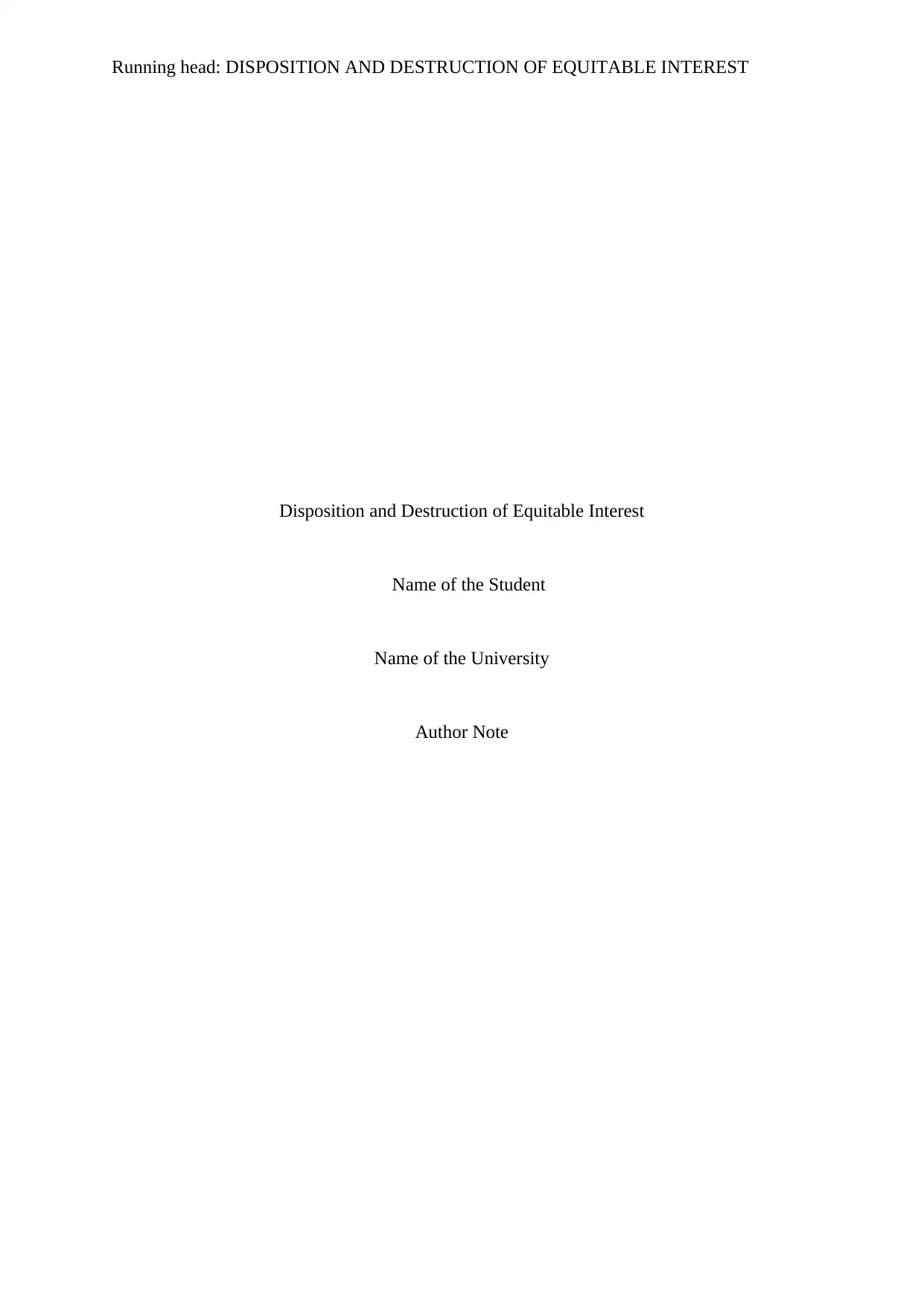
Running head: DISPOSITION AND DESTRUCTION OF EQUITABLE INTEREST
Disposition and Destruction of Equitable Interest
Name of the Student
Name of the University
Author Note
Disposition and Destruction of Equitable Interest
Name of the Student
Name of the University
Author Note
Paraphrase This Document
Need a fresh take? Get an instant paraphrase of this document with our AI Paraphraser
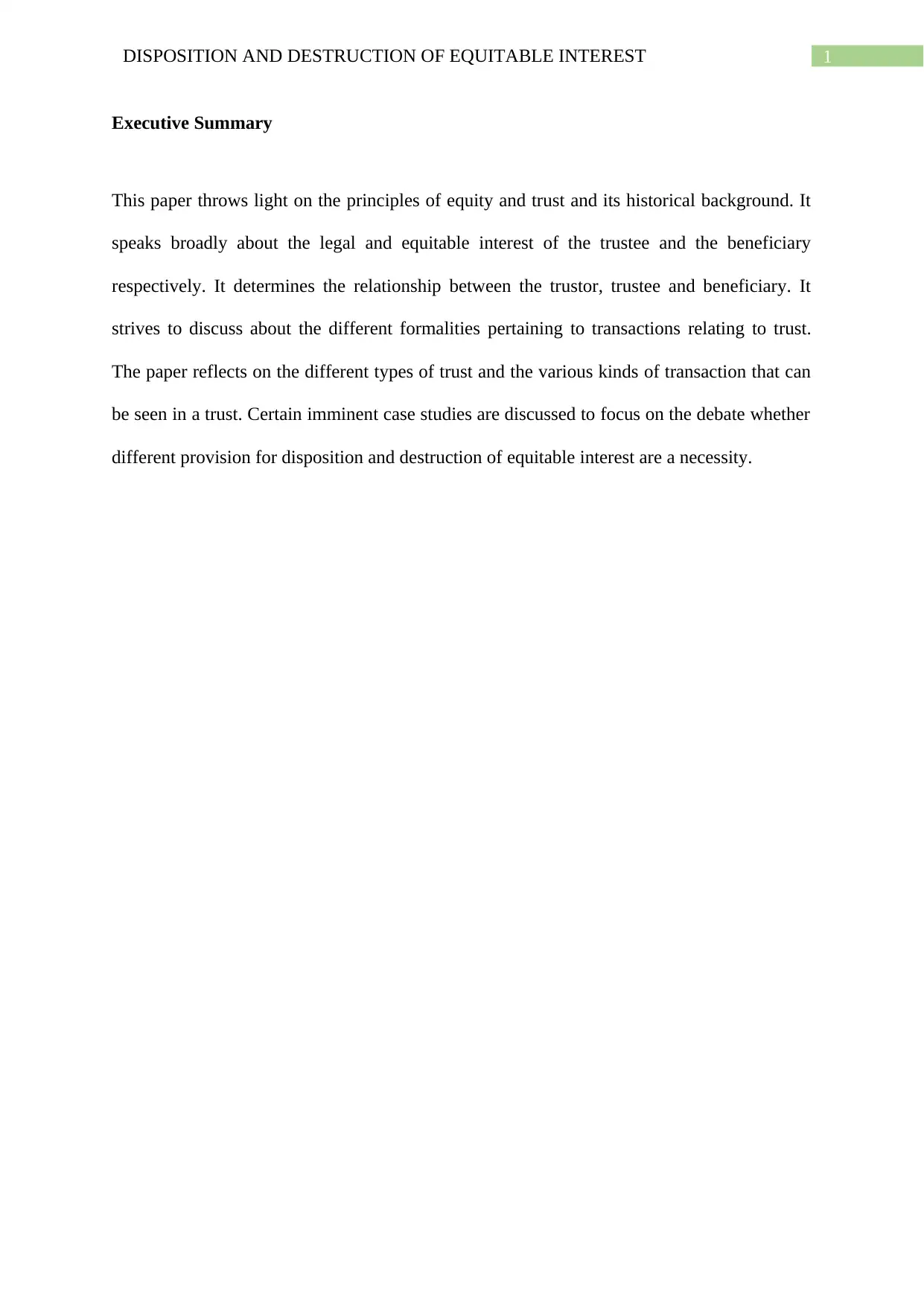
1DISPOSITION AND DESTRUCTION OF EQUITABLE INTEREST
Executive Summary
This paper throws light on the principles of equity and trust and its historical background. It
speaks broadly about the legal and equitable interest of the trustee and the beneficiary
respectively. It determines the relationship between the trustor, trustee and beneficiary. It
strives to discuss about the different formalities pertaining to transactions relating to trust.
The paper reflects on the different types of trust and the various kinds of transaction that can
be seen in a trust. Certain imminent case studies are discussed to focus on the debate whether
different provision for disposition and destruction of equitable interest are a necessity.
Executive Summary
This paper throws light on the principles of equity and trust and its historical background. It
speaks broadly about the legal and equitable interest of the trustee and the beneficiary
respectively. It determines the relationship between the trustor, trustee and beneficiary. It
strives to discuss about the different formalities pertaining to transactions relating to trust.
The paper reflects on the different types of trust and the various kinds of transaction that can
be seen in a trust. Certain imminent case studies are discussed to focus on the debate whether
different provision for disposition and destruction of equitable interest are a necessity.
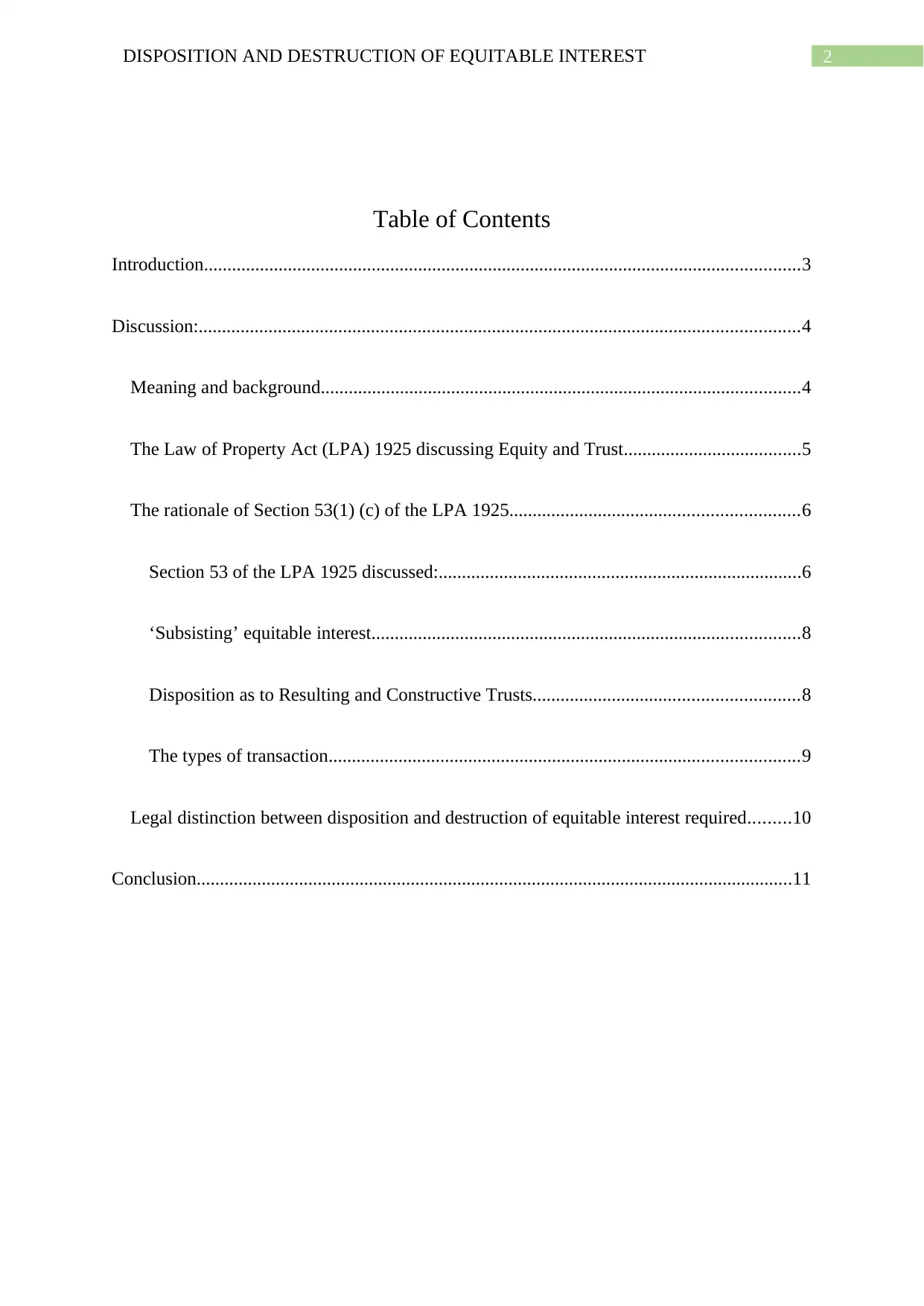
2DISPOSITION AND DESTRUCTION OF EQUITABLE INTEREST
Table of Contents
Introduction................................................................................................................................3
Discussion:.................................................................................................................................4
Meaning and background.......................................................................................................4
The Law of Property Act (LPA) 1925 discussing Equity and Trust......................................5
The rationale of Section 53(1) (c) of the LPA 1925..............................................................6
Section 53 of the LPA 1925 discussed:..............................................................................6
‘Subsisting’ equitable interest............................................................................................8
Disposition as to Resulting and Constructive Trusts.........................................................8
The types of transaction.....................................................................................................9
Legal distinction between disposition and destruction of equitable interest required.........10
Conclusion................................................................................................................................11
Table of Contents
Introduction................................................................................................................................3
Discussion:.................................................................................................................................4
Meaning and background.......................................................................................................4
The Law of Property Act (LPA) 1925 discussing Equity and Trust......................................5
The rationale of Section 53(1) (c) of the LPA 1925..............................................................6
Section 53 of the LPA 1925 discussed:..............................................................................6
‘Subsisting’ equitable interest............................................................................................8
Disposition as to Resulting and Constructive Trusts.........................................................8
The types of transaction.....................................................................................................9
Legal distinction between disposition and destruction of equitable interest required.........10
Conclusion................................................................................................................................11
⊘ This is a preview!⊘
Do you want full access?
Subscribe today to unlock all pages.

Trusted by 1+ million students worldwide
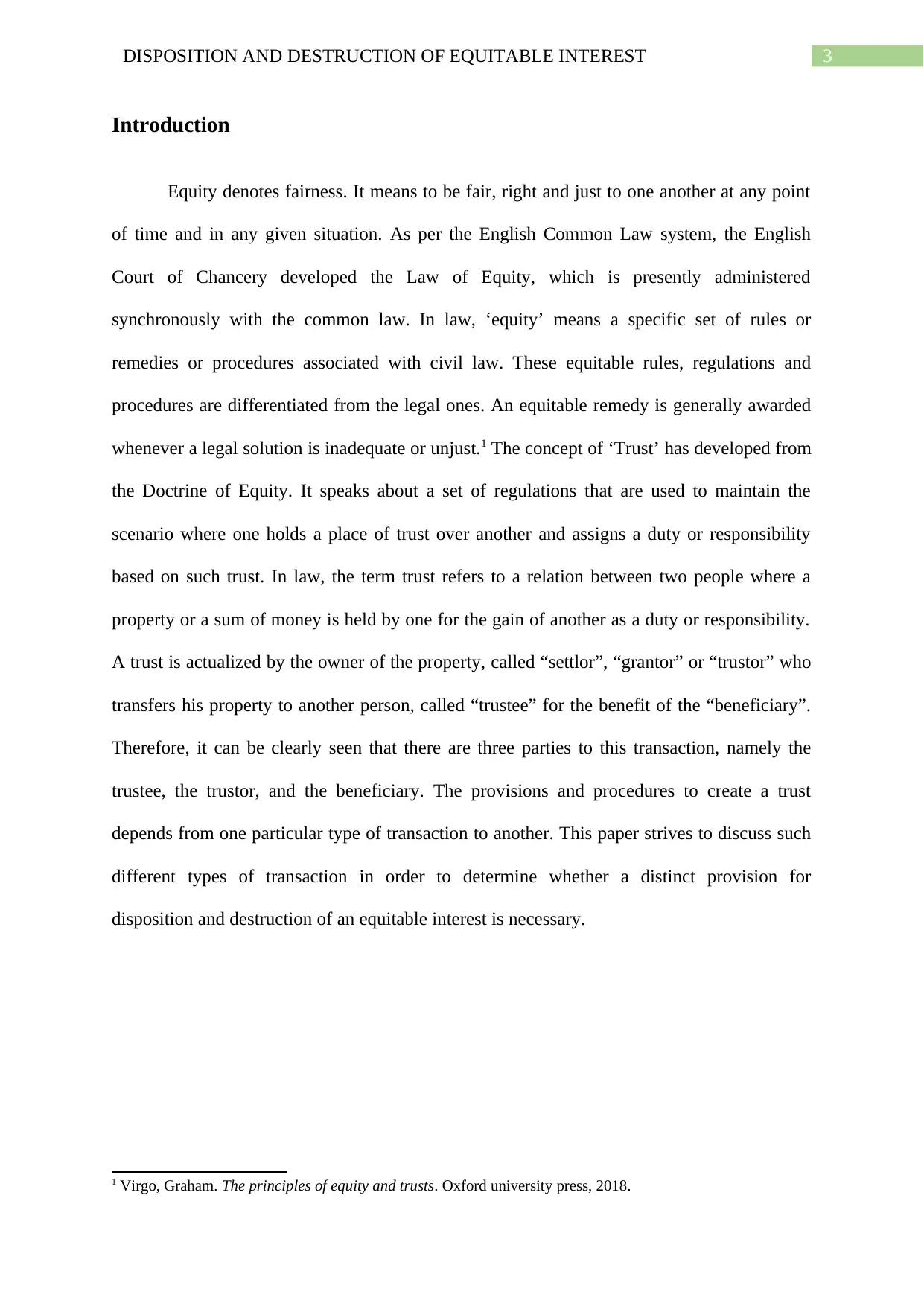
3DISPOSITION AND DESTRUCTION OF EQUITABLE INTEREST
Introduction
Equity denotes fairness. It means to be fair, right and just to one another at any point
of time and in any given situation. As per the English Common Law system, the English
Court of Chancery developed the Law of Equity, which is presently administered
synchronously with the common law. In law, ‘equity’ means a specific set of rules or
remedies or procedures associated with civil law. These equitable rules, regulations and
procedures are differentiated from the legal ones. An equitable remedy is generally awarded
whenever a legal solution is inadequate or unjust.1 The concept of ‘Trust’ has developed from
the Doctrine of Equity. It speaks about a set of regulations that are used to maintain the
scenario where one holds a place of trust over another and assigns a duty or responsibility
based on such trust. In law, the term trust refers to a relation between two people where a
property or a sum of money is held by one for the gain of another as a duty or responsibility.
A trust is actualized by the owner of the property, called “settlor”, “grantor” or “trustor” who
transfers his property to another person, called “trustee” for the benefit of the “beneficiary”.
Therefore, it can be clearly seen that there are three parties to this transaction, namely the
trustee, the trustor, and the beneficiary. The provisions and procedures to create a trust
depends from one particular type of transaction to another. This paper strives to discuss such
different types of transaction in order to determine whether a distinct provision for
disposition and destruction of an equitable interest is necessary.
1 Virgo, Graham. The principles of equity and trusts. Oxford university press, 2018.
Introduction
Equity denotes fairness. It means to be fair, right and just to one another at any point
of time and in any given situation. As per the English Common Law system, the English
Court of Chancery developed the Law of Equity, which is presently administered
synchronously with the common law. In law, ‘equity’ means a specific set of rules or
remedies or procedures associated with civil law. These equitable rules, regulations and
procedures are differentiated from the legal ones. An equitable remedy is generally awarded
whenever a legal solution is inadequate or unjust.1 The concept of ‘Trust’ has developed from
the Doctrine of Equity. It speaks about a set of regulations that are used to maintain the
scenario where one holds a place of trust over another and assigns a duty or responsibility
based on such trust. In law, the term trust refers to a relation between two people where a
property or a sum of money is held by one for the gain of another as a duty or responsibility.
A trust is actualized by the owner of the property, called “settlor”, “grantor” or “trustor” who
transfers his property to another person, called “trustee” for the benefit of the “beneficiary”.
Therefore, it can be clearly seen that there are three parties to this transaction, namely the
trustee, the trustor, and the beneficiary. The provisions and procedures to create a trust
depends from one particular type of transaction to another. This paper strives to discuss such
different types of transaction in order to determine whether a distinct provision for
disposition and destruction of an equitable interest is necessary.
1 Virgo, Graham. The principles of equity and trusts. Oxford university press, 2018.
Paraphrase This Document
Need a fresh take? Get an instant paraphrase of this document with our AI Paraphraser
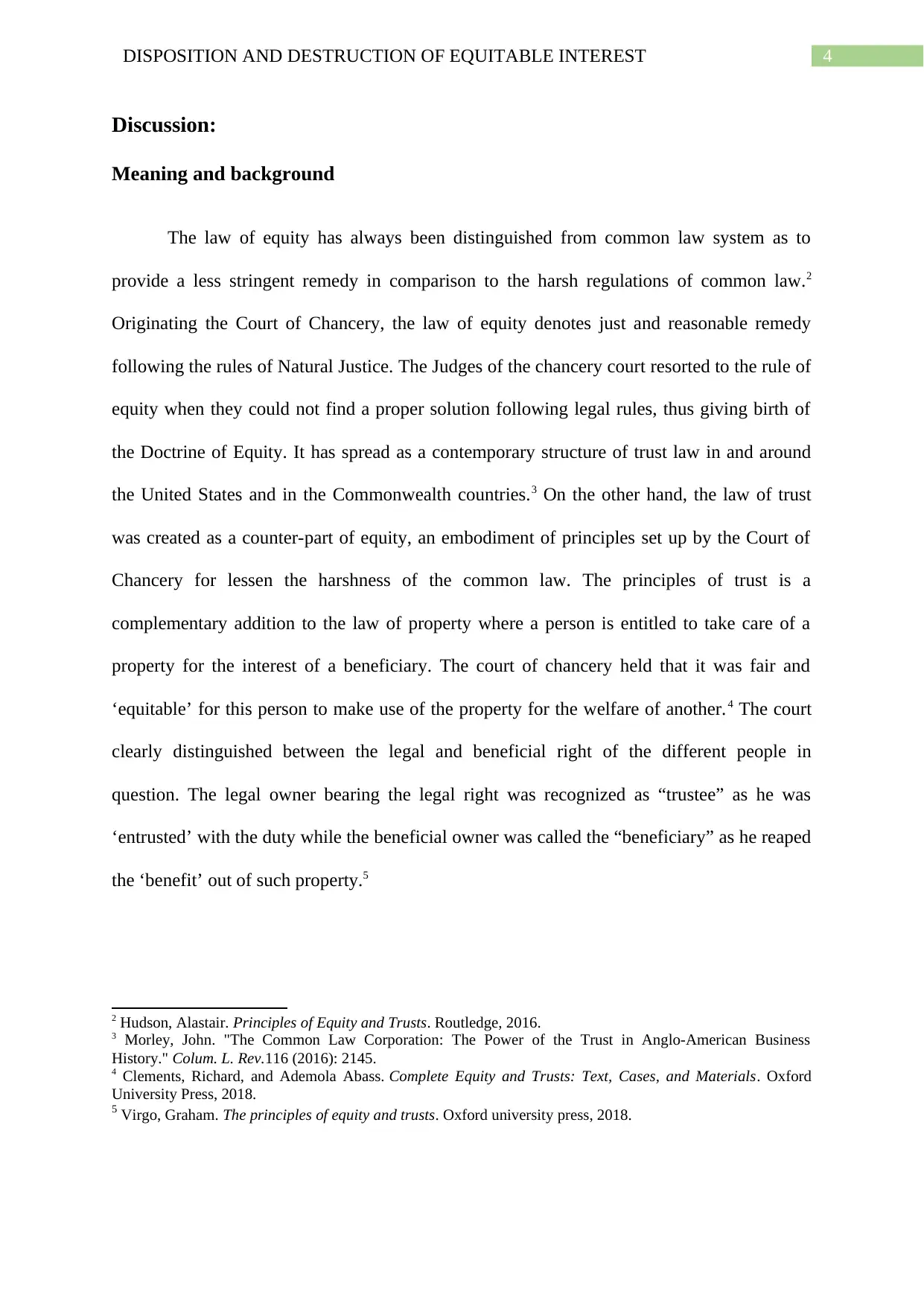
4DISPOSITION AND DESTRUCTION OF EQUITABLE INTEREST
Discussion:
Meaning and background
The law of equity has always been distinguished from common law system as to
provide a less stringent remedy in comparison to the harsh regulations of common law.2
Originating the Court of Chancery, the law of equity denotes just and reasonable remedy
following the rules of Natural Justice. The Judges of the chancery court resorted to the rule of
equity when they could not find a proper solution following legal rules, thus giving birth of
the Doctrine of Equity. It has spread as a contemporary structure of trust law in and around
the United States and in the Commonwealth countries.3 On the other hand, the law of trust
was created as a counter-part of equity, an embodiment of principles set up by the Court of
Chancery for lessen the harshness of the common law. The principles of trust is a
complementary addition to the law of property where a person is entitled to take care of a
property for the interest of a beneficiary. The court of chancery held that it was fair and
‘equitable’ for this person to make use of the property for the welfare of another.4 The court
clearly distinguished between the legal and beneficial right of the different people in
question. The legal owner bearing the legal right was recognized as “trustee” as he was
‘entrusted’ with the duty while the beneficial owner was called the “beneficiary” as he reaped
the ‘benefit’ out of such property.5
2 Hudson, Alastair. Principles of Equity and Trusts. Routledge, 2016.
3 Morley, John. "The Common Law Corporation: The Power of the Trust in Anglo-American Business
History." Colum. L. Rev.116 (2016): 2145.
4 Clements, Richard, and Ademola Abass. Complete Equity and Trusts: Text, Cases, and Materials. Oxford
University Press, 2018.
5 Virgo, Graham. The principles of equity and trusts. Oxford university press, 2018.
Discussion:
Meaning and background
The law of equity has always been distinguished from common law system as to
provide a less stringent remedy in comparison to the harsh regulations of common law.2
Originating the Court of Chancery, the law of equity denotes just and reasonable remedy
following the rules of Natural Justice. The Judges of the chancery court resorted to the rule of
equity when they could not find a proper solution following legal rules, thus giving birth of
the Doctrine of Equity. It has spread as a contemporary structure of trust law in and around
the United States and in the Commonwealth countries.3 On the other hand, the law of trust
was created as a counter-part of equity, an embodiment of principles set up by the Court of
Chancery for lessen the harshness of the common law. The principles of trust is a
complementary addition to the law of property where a person is entitled to take care of a
property for the interest of a beneficiary. The court of chancery held that it was fair and
‘equitable’ for this person to make use of the property for the welfare of another.4 The court
clearly distinguished between the legal and beneficial right of the different people in
question. The legal owner bearing the legal right was recognized as “trustee” as he was
‘entrusted’ with the duty while the beneficial owner was called the “beneficiary” as he reaped
the ‘benefit’ out of such property.5
2 Hudson, Alastair. Principles of Equity and Trusts. Routledge, 2016.
3 Morley, John. "The Common Law Corporation: The Power of the Trust in Anglo-American Business
History." Colum. L. Rev.116 (2016): 2145.
4 Clements, Richard, and Ademola Abass. Complete Equity and Trusts: Text, Cases, and Materials. Oxford
University Press, 2018.
5 Virgo, Graham. The principles of equity and trusts. Oxford university press, 2018.

5DISPOSITION AND DESTRUCTION OF EQUITABLE INTEREST
The Law of Property Act (LPA) 1925 discussing Equity and Trust
The LPA 1925 is a statute that was formulated by the Parliament of the United
Kingdom. It is an integral part of the legislative program promulgated by Lord Birkenhead,
the then Lord Chancellor between 1922 and 1925. Such programs were created to modernize
the face of English property law. This statute majorly deals with freehold or leasehold land
and their transfer by deed. The main policy of the Act was the reduction of the bulk of legal
estates and making the transfer of interest of such estates or land easier for the buyers. Some
other additional policies included mortgage, lease and trust properties, along with the lacunae
regarding the law of property. It has been amended a number of times since its
commencement. Currently, it comprises of provisions relating to the general principles of
legal estate and equitable interest, contracts and conveyances, mortgage, rent-charges and
power of attorney, lease and tenancy, perpetuities and accumulations, voidable dispositions
and will. It is divided into twelve parts and seven schedules. The Act categorizes different
types of trust.6
Classification of trusts
1. Express
2. Implied
3. Resulting
4. Constructive
An express trust7 appears when the ‘settlor’ or ‘trustor’ who is the absolute owner of the
property is expressly establishing it. An implied trust is created by some action of the
trustor, which is interpreted by the court as sufficient to establish a trust, but something that
6 Wilson, Sarah. "Law and Equity, and “Law and History” as a Resource of Critique." Pólemos 11.1 (2017): 23-
40.
7 Ramjohn, Mohamed. Unlocking Equity and Trusts. Routledge, 2017
The Law of Property Act (LPA) 1925 discussing Equity and Trust
The LPA 1925 is a statute that was formulated by the Parliament of the United
Kingdom. It is an integral part of the legislative program promulgated by Lord Birkenhead,
the then Lord Chancellor between 1922 and 1925. Such programs were created to modernize
the face of English property law. This statute majorly deals with freehold or leasehold land
and their transfer by deed. The main policy of the Act was the reduction of the bulk of legal
estates and making the transfer of interest of such estates or land easier for the buyers. Some
other additional policies included mortgage, lease and trust properties, along with the lacunae
regarding the law of property. It has been amended a number of times since its
commencement. Currently, it comprises of provisions relating to the general principles of
legal estate and equitable interest, contracts and conveyances, mortgage, rent-charges and
power of attorney, lease and tenancy, perpetuities and accumulations, voidable dispositions
and will. It is divided into twelve parts and seven schedules. The Act categorizes different
types of trust.6
Classification of trusts
1. Express
2. Implied
3. Resulting
4. Constructive
An express trust7 appears when the ‘settlor’ or ‘trustor’ who is the absolute owner of the
property is expressly establishing it. An implied trust is created by some action of the
trustor, which is interpreted by the court as sufficient to establish a trust, but something that
6 Wilson, Sarah. "Law and Equity, and “Law and History” as a Resource of Critique." Pólemos 11.1 (2017): 23-
40.
7 Ramjohn, Mohamed. Unlocking Equity and Trusts. Routledge, 2017
⊘ This is a preview!⊘
Do you want full access?
Subscribe today to unlock all pages.

Trusted by 1+ million students worldwide
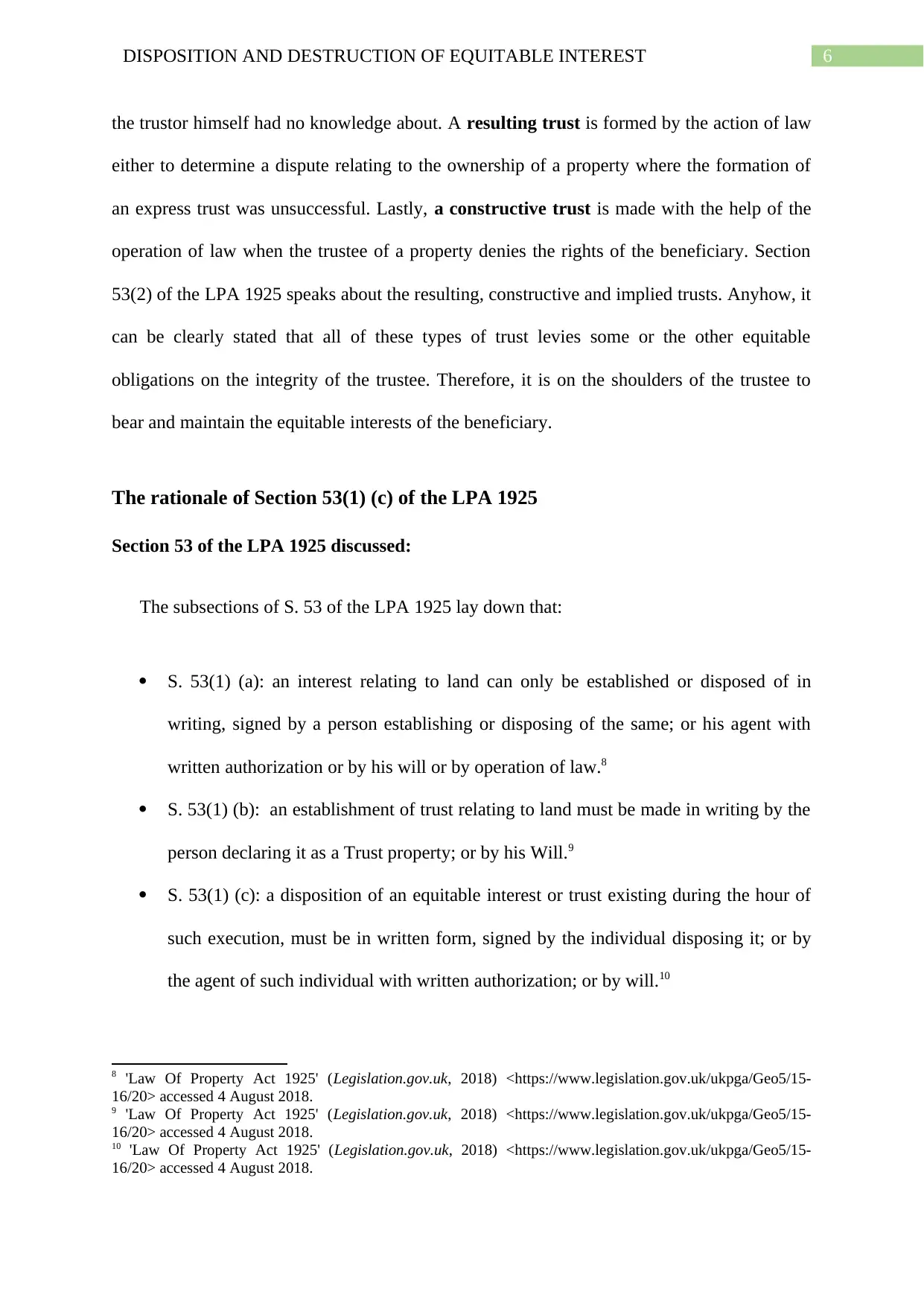
6DISPOSITION AND DESTRUCTION OF EQUITABLE INTEREST
the trustor himself had no knowledge about. A resulting trust is formed by the action of law
either to determine a dispute relating to the ownership of a property where the formation of
an express trust was unsuccessful. Lastly, a constructive trust is made with the help of the
operation of law when the trustee of a property denies the rights of the beneficiary. Section
53(2) of the LPA 1925 speaks about the resulting, constructive and implied trusts. Anyhow, it
can be clearly stated that all of these types of trust levies some or the other equitable
obligations on the integrity of the trustee. Therefore, it is on the shoulders of the trustee to
bear and maintain the equitable interests of the beneficiary.
The rationale of Section 53(1) (c) of the LPA 1925
Section 53 of the LPA 1925 discussed:
The subsections of S. 53 of the LPA 1925 lay down that:
S. 53(1) (a): an interest relating to land can only be established or disposed of in
writing, signed by a person establishing or disposing of the same; or his agent with
written authorization or by his will or by operation of law.8
S. 53(1) (b): an establishment of trust relating to land must be made in writing by the
person declaring it as a Trust property; or by his Will.9
S. 53(1) (c): a disposition of an equitable interest or trust existing during the hour of
such execution, must be in written form, signed by the individual disposing it; or by
the agent of such individual with written authorization; or by will.10
8 'Law Of Property Act 1925' (Legislation.gov.uk, 2018) <https://www.legislation.gov.uk/ukpga/Geo5/15-
16/20> accessed 4 August 2018.
9 'Law Of Property Act 1925' (Legislation.gov.uk, 2018) <https://www.legislation.gov.uk/ukpga/Geo5/15-
16/20> accessed 4 August 2018.
10 'Law Of Property Act 1925' (Legislation.gov.uk, 2018) <https://www.legislation.gov.uk/ukpga/Geo5/15-
16/20> accessed 4 August 2018.
the trustor himself had no knowledge about. A resulting trust is formed by the action of law
either to determine a dispute relating to the ownership of a property where the formation of
an express trust was unsuccessful. Lastly, a constructive trust is made with the help of the
operation of law when the trustee of a property denies the rights of the beneficiary. Section
53(2) of the LPA 1925 speaks about the resulting, constructive and implied trusts. Anyhow, it
can be clearly stated that all of these types of trust levies some or the other equitable
obligations on the integrity of the trustee. Therefore, it is on the shoulders of the trustee to
bear and maintain the equitable interests of the beneficiary.
The rationale of Section 53(1) (c) of the LPA 1925
Section 53 of the LPA 1925 discussed:
The subsections of S. 53 of the LPA 1925 lay down that:
S. 53(1) (a): an interest relating to land can only be established or disposed of in
writing, signed by a person establishing or disposing of the same; or his agent with
written authorization or by his will or by operation of law.8
S. 53(1) (b): an establishment of trust relating to land must be made in writing by the
person declaring it as a Trust property; or by his Will.9
S. 53(1) (c): a disposition of an equitable interest or trust existing during the hour of
such execution, must be in written form, signed by the individual disposing it; or by
the agent of such individual with written authorization; or by will.10
8 'Law Of Property Act 1925' (Legislation.gov.uk, 2018) <https://www.legislation.gov.uk/ukpga/Geo5/15-
16/20> accessed 4 August 2018.
9 'Law Of Property Act 1925' (Legislation.gov.uk, 2018) <https://www.legislation.gov.uk/ukpga/Geo5/15-
16/20> accessed 4 August 2018.
10 'Law Of Property Act 1925' (Legislation.gov.uk, 2018) <https://www.legislation.gov.uk/ukpga/Geo5/15-
16/20> accessed 4 August 2018.
Paraphrase This Document
Need a fresh take? Get an instant paraphrase of this document with our AI Paraphraser
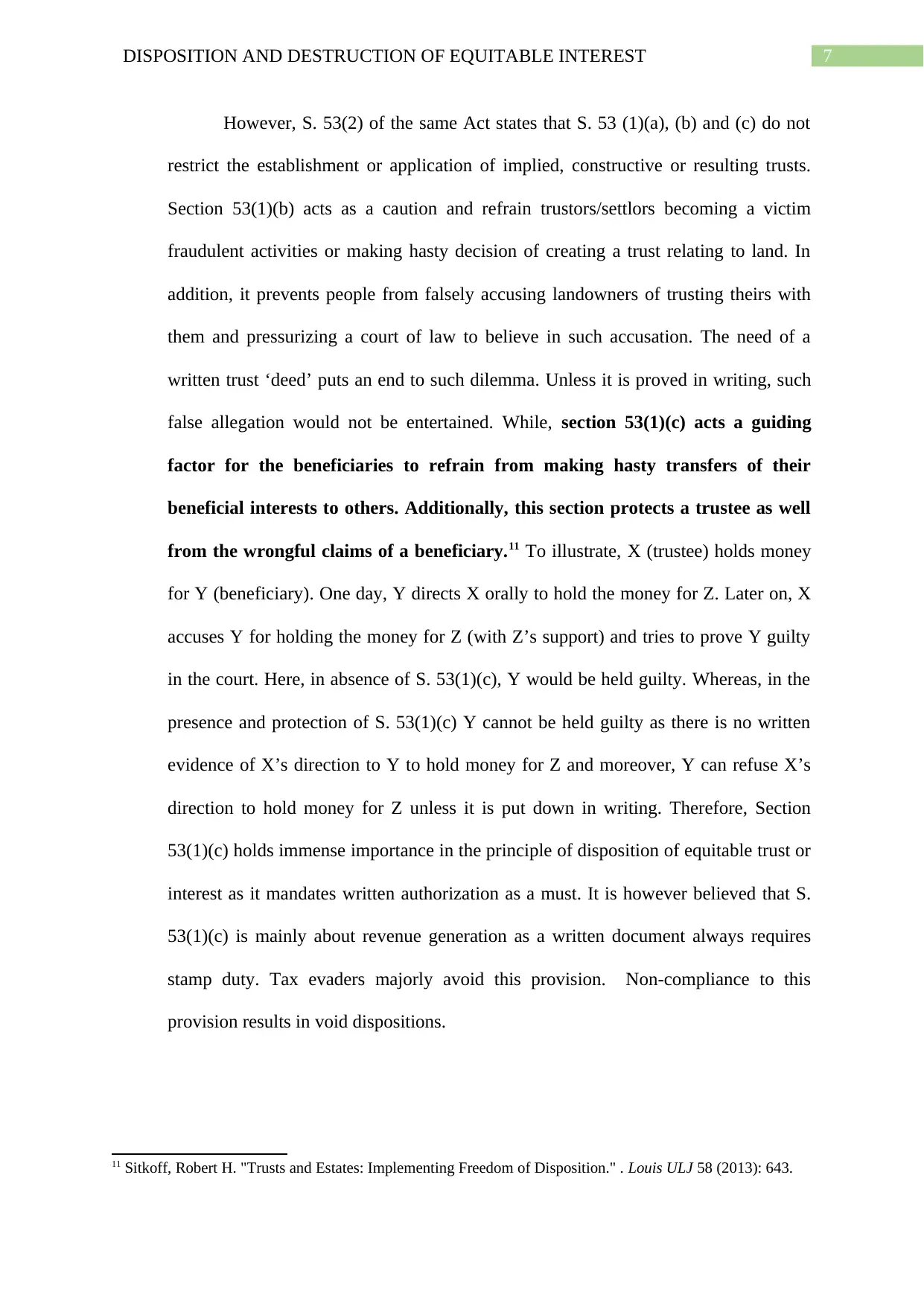
7DISPOSITION AND DESTRUCTION OF EQUITABLE INTEREST
However, S. 53(2) of the same Act states that S. 53 (1)(a), (b) and (c) do not
restrict the establishment or application of implied, constructive or resulting trusts.
Section 53(1)(b) acts as a caution and refrain trustors/settlors becoming a victim
fraudulent activities or making hasty decision of creating a trust relating to land. In
addition, it prevents people from falsely accusing landowners of trusting theirs with
them and pressurizing a court of law to believe in such accusation. The need of a
written trust ‘deed’ puts an end to such dilemma. Unless it is proved in writing, such
false allegation would not be entertained. While, section 53(1)(c) acts a guiding
factor for the beneficiaries to refrain from making hasty transfers of their
beneficial interests to others. Additionally, this section protects a trustee as well
from the wrongful claims of a beneficiary.11 To illustrate, X (trustee) holds money
for Y (beneficiary). One day, Y directs X orally to hold the money for Z. Later on, X
accuses Y for holding the money for Z (with Z’s support) and tries to prove Y guilty
in the court. Here, in absence of S. 53(1)(c), Y would be held guilty. Whereas, in the
presence and protection of S. 53(1)(c) Y cannot be held guilty as there is no written
evidence of X’s direction to Y to hold money for Z and moreover, Y can refuse X’s
direction to hold money for Z unless it is put down in writing. Therefore, Section
53(1)(c) holds immense importance in the principle of disposition of equitable trust or
interest as it mandates written authorization as a must. It is however believed that S.
53(1)(c) is mainly about revenue generation as a written document always requires
stamp duty. Tax evaders majorly avoid this provision. Non-compliance to this
provision results in void dispositions.
11 Sitkoff, Robert H. "Trusts and Estates: Implementing Freedom of Disposition." . Louis ULJ 58 (2013): 643.
However, S. 53(2) of the same Act states that S. 53 (1)(a), (b) and (c) do not
restrict the establishment or application of implied, constructive or resulting trusts.
Section 53(1)(b) acts as a caution and refrain trustors/settlors becoming a victim
fraudulent activities or making hasty decision of creating a trust relating to land. In
addition, it prevents people from falsely accusing landowners of trusting theirs with
them and pressurizing a court of law to believe in such accusation. The need of a
written trust ‘deed’ puts an end to such dilemma. Unless it is proved in writing, such
false allegation would not be entertained. While, section 53(1)(c) acts a guiding
factor for the beneficiaries to refrain from making hasty transfers of their
beneficial interests to others. Additionally, this section protects a trustee as well
from the wrongful claims of a beneficiary.11 To illustrate, X (trustee) holds money
for Y (beneficiary). One day, Y directs X orally to hold the money for Z. Later on, X
accuses Y for holding the money for Z (with Z’s support) and tries to prove Y guilty
in the court. Here, in absence of S. 53(1)(c), Y would be held guilty. Whereas, in the
presence and protection of S. 53(1)(c) Y cannot be held guilty as there is no written
evidence of X’s direction to Y to hold money for Z and moreover, Y can refuse X’s
direction to hold money for Z unless it is put down in writing. Therefore, Section
53(1)(c) holds immense importance in the principle of disposition of equitable trust or
interest as it mandates written authorization as a must. It is however believed that S.
53(1)(c) is mainly about revenue generation as a written document always requires
stamp duty. Tax evaders majorly avoid this provision. Non-compliance to this
provision results in void dispositions.
11 Sitkoff, Robert H. "Trusts and Estates: Implementing Freedom of Disposition." . Louis ULJ 58 (2013): 643.

8DISPOSITION AND DESTRUCTION OF EQUITABLE INTEREST
‘Subsisting’ equitable interest
A limitation of the provision of S. 53(1)(c) is that it only applies to an existing
equitable interest, which means it can only be applied for the beneficiary’s concern under an
existing trust.12 It is however non-applicable to original establishment of trust. It can only be
used when a beneficiary wants to dispose of his interest on trust.13 To elucidate, M
(trustor/settlor) selects N as the trustee for holding a property for O (beneficiary). Here, M
holds the legal title to the property while O holds and relish the equitable interest. The
formalities that M (trustor) needs to carry out would depend upon the particular type of
transfer of property concerned. It does not fall within the ambit of section 53(1)(c). 14
Disposition as to Resulting and Constructive Trusts
In Re Vandervell’s Trust,15 Vandervell directed the trust company to opt for
repurchasing to evade surtax liability. But it was held to be not possible as Vandervell’s
equitable interest on such company had extinguished. Lord Denning observed and expressed
that there was an existence of Resulting Trust for there is a question of protecting the
children’s settlement money. However, Lawton LJ terminated the resulting trust as
Vandervell’s equitable interest had extinguished.
In Grey v. IRC,16 it was opined that verbal direction given by the primary beneficiary
to his trustee to retain the property for the secondary beneficiary results in a disposition.
However, if the primary beneficiary signs a contracts with the secondary beneficiary to
12 Pearce, Robert A., and Warren Barr. Pearce & Stevens' Trusts and Equitable Obligations. Oxford University
Press, USA, 2015.
13 Watt, Gary. Cases and Materials on Equity and Trusts. Oxford University Press, 2016.
14 Harris, Jonathan. "The Hague Trusts Convention after Akers v Samba." Trusts & Trustees 24.4 (2018): 346-
363.
15 Mee, John. "The Past, Present, and Future of Resulting Trusts." Current Legal Problems 70.1 (2017): 189-
225.
16 Paul Davies, Equity & Trusts: Text, Cases and Materials (OUP, 2013) 18-19.
‘Subsisting’ equitable interest
A limitation of the provision of S. 53(1)(c) is that it only applies to an existing
equitable interest, which means it can only be applied for the beneficiary’s concern under an
existing trust.12 It is however non-applicable to original establishment of trust. It can only be
used when a beneficiary wants to dispose of his interest on trust.13 To elucidate, M
(trustor/settlor) selects N as the trustee for holding a property for O (beneficiary). Here, M
holds the legal title to the property while O holds and relish the equitable interest. The
formalities that M (trustor) needs to carry out would depend upon the particular type of
transfer of property concerned. It does not fall within the ambit of section 53(1)(c). 14
Disposition as to Resulting and Constructive Trusts
In Re Vandervell’s Trust,15 Vandervell directed the trust company to opt for
repurchasing to evade surtax liability. But it was held to be not possible as Vandervell’s
equitable interest on such company had extinguished. Lord Denning observed and expressed
that there was an existence of Resulting Trust for there is a question of protecting the
children’s settlement money. However, Lawton LJ terminated the resulting trust as
Vandervell’s equitable interest had extinguished.
In Grey v. IRC,16 it was opined that verbal direction given by the primary beneficiary
to his trustee to retain the property for the secondary beneficiary results in a disposition.
However, if the primary beneficiary signs a contracts with the secondary beneficiary to
12 Pearce, Robert A., and Warren Barr. Pearce & Stevens' Trusts and Equitable Obligations. Oxford University
Press, USA, 2015.
13 Watt, Gary. Cases and Materials on Equity and Trusts. Oxford University Press, 2016.
14 Harris, Jonathan. "The Hague Trusts Convention after Akers v Samba." Trusts & Trustees 24.4 (2018): 346-
363.
15 Mee, John. "The Past, Present, and Future of Resulting Trusts." Current Legal Problems 70.1 (2017): 189-
225.
16 Paul Davies, Equity & Trusts: Text, Cases and Materials (OUP, 2013) 18-19.
⊘ This is a preview!⊘
Do you want full access?
Subscribe today to unlock all pages.

Trusted by 1+ million students worldwide
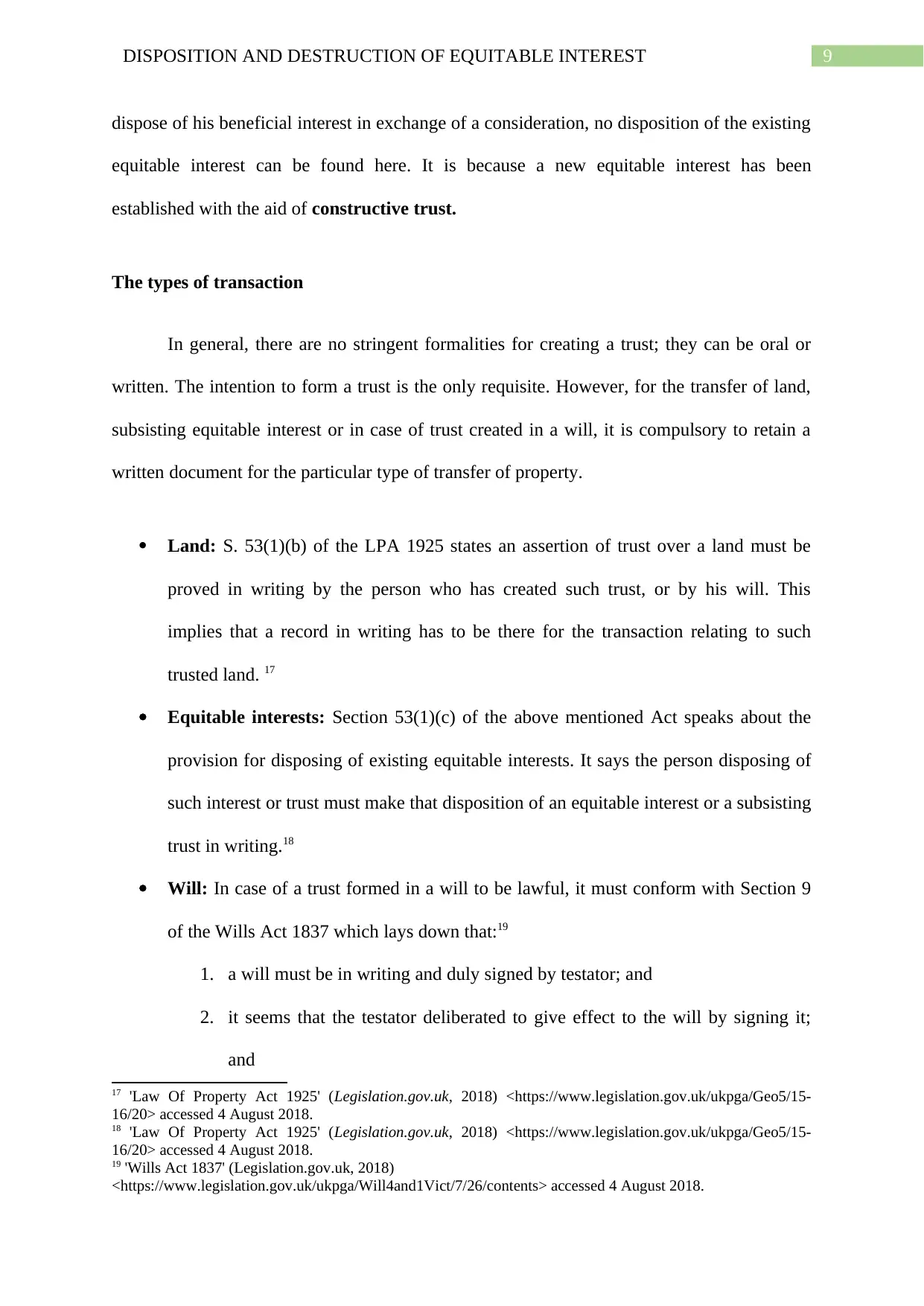
9DISPOSITION AND DESTRUCTION OF EQUITABLE INTEREST
dispose of his beneficial interest in exchange of a consideration, no disposition of the existing
equitable interest can be found here. It is because a new equitable interest has been
established with the aid of constructive trust.
The types of transaction
In general, there are no stringent formalities for creating a trust; they can be oral or
written. The intention to form a trust is the only requisite. However, for the transfer of land,
subsisting equitable interest or in case of trust created in a will, it is compulsory to retain a
written document for the particular type of transfer of property.
Land: S. 53(1)(b) of the LPA 1925 states an assertion of trust over a land must be
proved in writing by the person who has created such trust, or by his will. This
implies that a record in writing has to be there for the transaction relating to such
trusted land. 17
Equitable interests: Section 53(1)(c) of the above mentioned Act speaks about the
provision for disposing of existing equitable interests. It says the person disposing of
such interest or trust must make that disposition of an equitable interest or a subsisting
trust in writing.18
Will: In case of a trust formed in a will to be lawful, it must conform with Section 9
of the Wills Act 1837 which lays down that:19
1. a will must be in writing and duly signed by testator; and
2. it seems that the testator deliberated to give effect to the will by signing it;
and
17 'Law Of Property Act 1925' (Legislation.gov.uk, 2018) <https://www.legislation.gov.uk/ukpga/Geo5/15-
16/20> accessed 4 August 2018.
18 'Law Of Property Act 1925' (Legislation.gov.uk, 2018) <https://www.legislation.gov.uk/ukpga/Geo5/15-
16/20> accessed 4 August 2018.
19 'Wills Act 1837' (Legislation.gov.uk, 2018)
<https://www.legislation.gov.uk/ukpga/Will4and1Vict/7/26/contents> accessed 4 August 2018.
dispose of his beneficial interest in exchange of a consideration, no disposition of the existing
equitable interest can be found here. It is because a new equitable interest has been
established with the aid of constructive trust.
The types of transaction
In general, there are no stringent formalities for creating a trust; they can be oral or
written. The intention to form a trust is the only requisite. However, for the transfer of land,
subsisting equitable interest or in case of trust created in a will, it is compulsory to retain a
written document for the particular type of transfer of property.
Land: S. 53(1)(b) of the LPA 1925 states an assertion of trust over a land must be
proved in writing by the person who has created such trust, or by his will. This
implies that a record in writing has to be there for the transaction relating to such
trusted land. 17
Equitable interests: Section 53(1)(c) of the above mentioned Act speaks about the
provision for disposing of existing equitable interests. It says the person disposing of
such interest or trust must make that disposition of an equitable interest or a subsisting
trust in writing.18
Will: In case of a trust formed in a will to be lawful, it must conform with Section 9
of the Wills Act 1837 which lays down that:19
1. a will must be in writing and duly signed by testator; and
2. it seems that the testator deliberated to give effect to the will by signing it;
and
17 'Law Of Property Act 1925' (Legislation.gov.uk, 2018) <https://www.legislation.gov.uk/ukpga/Geo5/15-
16/20> accessed 4 August 2018.
18 'Law Of Property Act 1925' (Legislation.gov.uk, 2018) <https://www.legislation.gov.uk/ukpga/Geo5/15-
16/20> accessed 4 August 2018.
19 'Wills Act 1837' (Legislation.gov.uk, 2018)
<https://www.legislation.gov.uk/ukpga/Will4and1Vict/7/26/contents> accessed 4 August 2018.
Paraphrase This Document
Need a fresh take? Get an instant paraphrase of this document with our AI Paraphraser
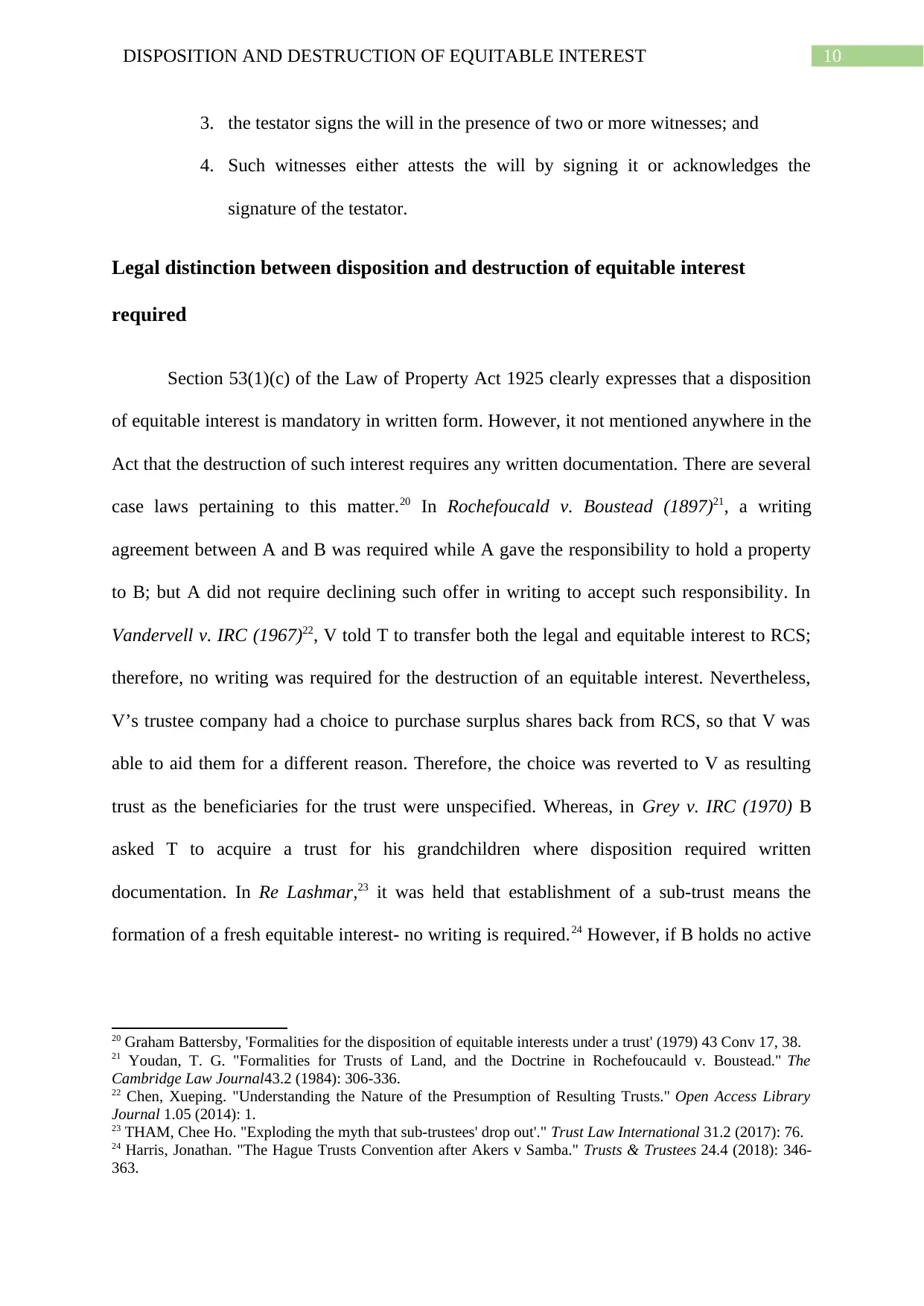
10DISPOSITION AND DESTRUCTION OF EQUITABLE INTEREST
3. the testator signs the will in the presence of two or more witnesses; and
4. Such witnesses either attests the will by signing it or acknowledges the
signature of the testator.
Legal distinction between disposition and destruction of equitable interest
required
Section 53(1)(c) of the Law of Property Act 1925 clearly expresses that a disposition
of equitable interest is mandatory in written form. However, it not mentioned anywhere in the
Act that the destruction of such interest requires any written documentation. There are several
case laws pertaining to this matter.20 In Rochefoucald v. Boustead (1897)21, a writing
agreement between A and B was required while A gave the responsibility to hold a property
to B; but A did not require declining such offer in writing to accept such responsibility. In
Vandervell v. IRC (1967)22, V told T to transfer both the legal and equitable interest to RCS;
therefore, no writing was required for the destruction of an equitable interest. Nevertheless,
V’s trustee company had a choice to purchase surplus shares back from RCS, so that V was
able to aid them for a different reason. Therefore, the choice was reverted to V as resulting
trust as the beneficiaries for the trust were unspecified. Whereas, in Grey v. IRC (1970) B
asked T to acquire a trust for his grandchildren where disposition required written
documentation. In Re Lashmar,23 it was held that establishment of a sub-trust means the
formation of a fresh equitable interest- no writing is required.24 However, if B holds no active
20 Graham Battersby, 'Formalities for the disposition of equitable interests under a trust' (1979) 43 Conv 17, 38.
21 Youdan, T. G. "Formalities for Trusts of Land, and the Doctrine in Rochefoucauld v. Boustead." The
Cambridge Law Journal43.2 (1984): 306-336.
22 Chen, Xueping. "Understanding the Nature of the Presumption of Resulting Trusts." Open Access Library
Journal 1.05 (2014): 1.
23 THAM, Chee Ho. "Exploding the myth that sub-trustees' drop out'." Trust Law International 31.2 (2017): 76.
24 Harris, Jonathan. "The Hague Trusts Convention after Akers v Samba." Trusts & Trustees 24.4 (2018): 346-
363.
3. the testator signs the will in the presence of two or more witnesses; and
4. Such witnesses either attests the will by signing it or acknowledges the
signature of the testator.
Legal distinction between disposition and destruction of equitable interest
required
Section 53(1)(c) of the Law of Property Act 1925 clearly expresses that a disposition
of equitable interest is mandatory in written form. However, it not mentioned anywhere in the
Act that the destruction of such interest requires any written documentation. There are several
case laws pertaining to this matter.20 In Rochefoucald v. Boustead (1897)21, a writing
agreement between A and B was required while A gave the responsibility to hold a property
to B; but A did not require declining such offer in writing to accept such responsibility. In
Vandervell v. IRC (1967)22, V told T to transfer both the legal and equitable interest to RCS;
therefore, no writing was required for the destruction of an equitable interest. Nevertheless,
V’s trustee company had a choice to purchase surplus shares back from RCS, so that V was
able to aid them for a different reason. Therefore, the choice was reverted to V as resulting
trust as the beneficiaries for the trust were unspecified. Whereas, in Grey v. IRC (1970) B
asked T to acquire a trust for his grandchildren where disposition required written
documentation. In Re Lashmar,23 it was held that establishment of a sub-trust means the
formation of a fresh equitable interest- no writing is required.24 However, if B holds no active
20 Graham Battersby, 'Formalities for the disposition of equitable interests under a trust' (1979) 43 Conv 17, 38.
21 Youdan, T. G. "Formalities for Trusts of Land, and the Doctrine in Rochefoucauld v. Boustead." The
Cambridge Law Journal43.2 (1984): 306-336.
22 Chen, Xueping. "Understanding the Nature of the Presumption of Resulting Trusts." Open Access Library
Journal 1.05 (2014): 1.
23 THAM, Chee Ho. "Exploding the myth that sub-trustees' drop out'." Trust Law International 31.2 (2017): 76.
24 Harris, Jonathan. "The Hague Trusts Convention after Akers v Samba." Trusts & Trustees 24.4 (2018): 346-
363.
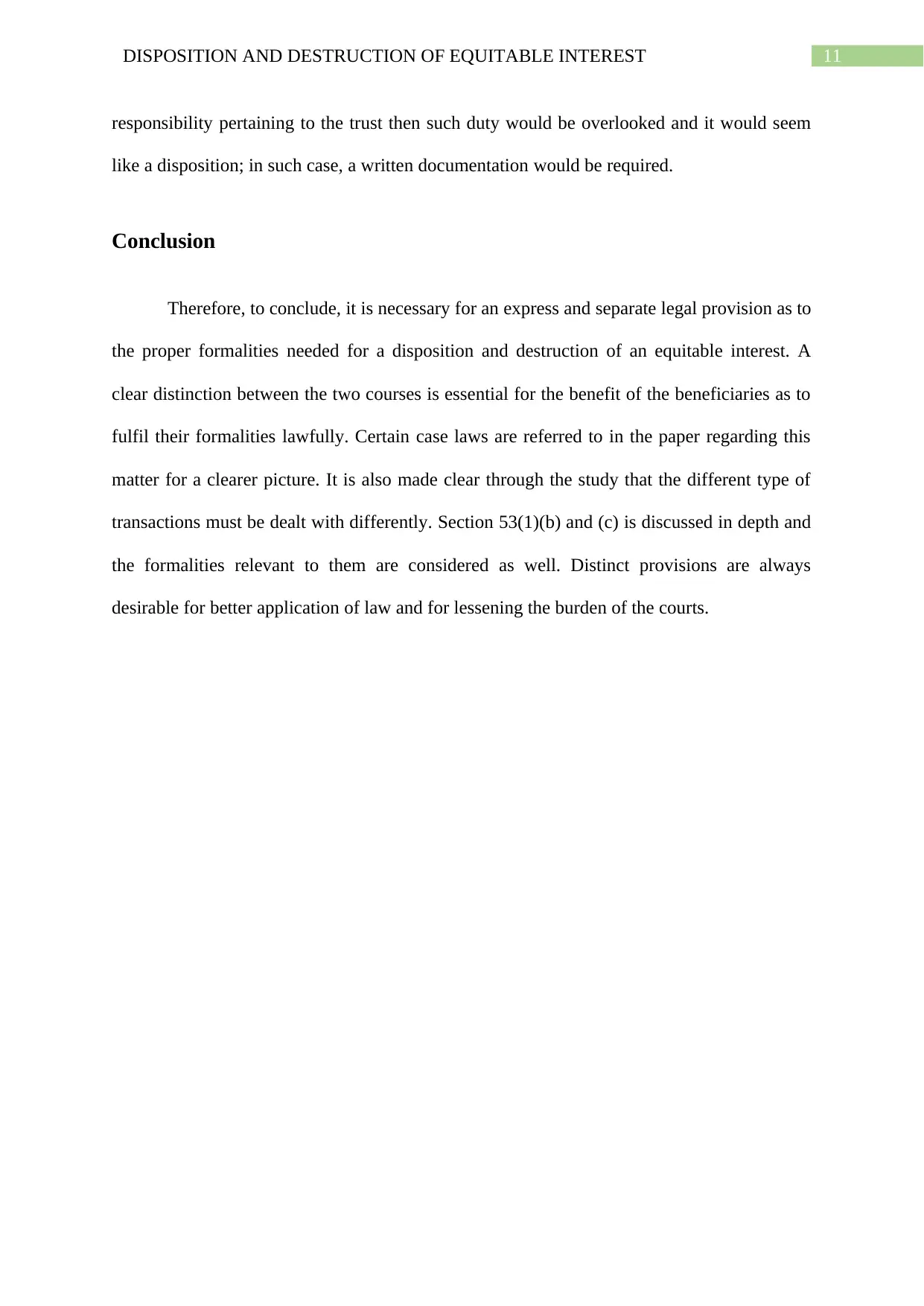
11DISPOSITION AND DESTRUCTION OF EQUITABLE INTEREST
responsibility pertaining to the trust then such duty would be overlooked and it would seem
like a disposition; in such case, a written documentation would be required.
Conclusion
Therefore, to conclude, it is necessary for an express and separate legal provision as to
the proper formalities needed for a disposition and destruction of an equitable interest. A
clear distinction between the two courses is essential for the benefit of the beneficiaries as to
fulfil their formalities lawfully. Certain case laws are referred to in the paper regarding this
matter for a clearer picture. It is also made clear through the study that the different type of
transactions must be dealt with differently. Section 53(1)(b) and (c) is discussed in depth and
the formalities relevant to them are considered as well. Distinct provisions are always
desirable for better application of law and for lessening the burden of the courts.
responsibility pertaining to the trust then such duty would be overlooked and it would seem
like a disposition; in such case, a written documentation would be required.
Conclusion
Therefore, to conclude, it is necessary for an express and separate legal provision as to
the proper formalities needed for a disposition and destruction of an equitable interest. A
clear distinction between the two courses is essential for the benefit of the beneficiaries as to
fulfil their formalities lawfully. Certain case laws are referred to in the paper regarding this
matter for a clearer picture. It is also made clear through the study that the different type of
transactions must be dealt with differently. Section 53(1)(b) and (c) is discussed in depth and
the formalities relevant to them are considered as well. Distinct provisions are always
desirable for better application of law and for lessening the burden of the courts.
⊘ This is a preview!⊘
Do you want full access?
Subscribe today to unlock all pages.

Trusted by 1+ million students worldwide
1 out of 15
Related Documents
Your All-in-One AI-Powered Toolkit for Academic Success.
+13062052269
info@desklib.com
Available 24*7 on WhatsApp / Email
![[object Object]](/_next/static/media/star-bottom.7253800d.svg)
Unlock your academic potential
Copyright © 2020–2025 A2Z Services. All Rights Reserved. Developed and managed by ZUCOL.





